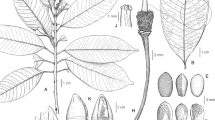Abstract
Salix taxifolia s.1., originally described as two species, has been treated as either a single species, or as two varieties: var.taxifolia and var.microphylla. Morphological, chemical, and phytogeographical evidence supports treatingSalix taxifolia andS. microphylla as species. These taxa are distinguished on the basis of leaf length, leaf length-width ratio, the number of teeth or glands on the leaf margins, the presence or absence of abaxial nectaries in the staminate flowers, the presence or absence of foliar stipules, and by their flavonoid profiles. Their geographical ranges are different and come into contact only in the state of Durango, Mexico. Phenetically, all of the subgroups ofS. taxifolia are more similar to each other than they are toS. microphylla. Both of these taxa are morphologically more similar to each other than they are to other members of sect.Longifoliae. A key to the species and descriptions are provided.
Similar content being viewed by others
Literature Cited
Andersson, N. J. 1867. Monographia Salicum. Kongl. Svenska Vetensk. Acad. Handl. 6(1).
—. 1868. Salicineae. Pages 190–331.In: A. P. DeCandolle, editor. Prodromus 16(2). Paris, Strasbourg, and London: Treuttel et Würtz.
Anon. 1991. inFOcus/QUIKMap—a desktop GIS. Earth and Ocean Research Ltd., Dartmouth, NS and Environmental Sciences Ltd., Sidney, BC.
Averett, J. E. 1977. Absorption maxima and Rf values as an aid to the identification of selected flavonoids. Phytochem. Bull. 10: 10–26.
Ball, C. R. 1961.Salix. Pages 369–392.In: C. L. Lundell & Collaborators. Flora of Texas 3(6).
Brunsfeld, S. J., D. E. Soltis &P. S. Soltis. 1991. Patterns of genetic variation inSalix sectionLongifoliae (Salicaceae). Amer. J. Bot. 78: 855–869.
—, —, — 1992. Evolutionary patterns and processes inSalix sect.Longifoliae: evidence from chloroplast DNA. Syst. Bot. 17: 239–256.
Crawford, D. J. 1974. A morphological and chemical study ofPopulus angustifolia Rydberg. Brittonia 26: 74–89.
Dallwitz M. J. & T. A. Paine. 1986. Users guide to the DELTA system. A general system for processing taxonomic descriptions. 3rd ed. Commonwealth Scientific and Industrial Research Organization, Australia. Division of Entomology Report No. 13.
- & -. 1990. The Distance Matrix Program Dist. Delta changes—19 August 1990. Unpublished.
Dorn, R. D. 1975. A systematic study ofSalix sectionCordatae in North America. Canad. J. Bot. 53:1491–1522.
Giannasi, D. E. 1975. The flavonoid systematics of the genusDahlia (Compositae). Mem. New York Bot. Gard. 26(2): 1–125.
— &T. I. Chuang. 1976. Flavonoid systematics of the genusPerideridia (Umbelliferae). Brittonia 28: 177–194.
Hubbs, C. L. &C. Hubbs. 1953. An improved graphical analysis and comparison of series of samples. Syst. Zoo. 2: 49–56, 92.
Johnston, I. M. 1944. Plants of Coahuila, eastern Chihuahua, and adjoining Zacatecas and Durango, IV. J. Arnold Arbor. 25: 431–453.
Mabry, T. J., K. R. Markham &M. B. Thomas. 1970. The systematic identification of flavonoids. Springer-Verlag, New York.
Nee, M. 1984. Salicaceae. Flora de Veracruz 34: 1–24. INIREB, Xalapa.
Rowlee, W. W. 1900. North American willows, I. Longifoliae. Bull. Torrey Bot. Club 27: 247–257.
Schneider, C. 1918. A conspectus of Mexican, West Indian, Central and South American species and varieties ofSalix. Bot. Gaz. (Crawfordville) 65: 1–41.
Standley, P. C. 1920. Trees and shrubs of Mexico. Contr. U.S. Natl. Herb. 23: 1–848.
— &J. A. Steyermark. 1952.Salix. Flora of Guatemala. Fieldiana, Bot. 24 P. III: 343–348.
Sudworth, G. B. 1934. Poplars, principal tree willows and walnuts of the Rocky Mountain region. Techn. Bull. U.S.D.A. 420.
Wilkinson, L. 1988. SYSTAT: The system for statistics. Systat, Inc., Evanston, Illinois.
Author information
Authors and Affiliations
Rights and permissions
About this article
Cite this article
Argus, G.W., McJannet, C.L. A taxonomic reconsideration of Salix taxifolia sensu lato (Salicaceae). Brittonia 44, 461–474 (1992). https://doi.org/10.2307/2807196
Issue Date:
DOI: https://doi.org/10.2307/2807196




